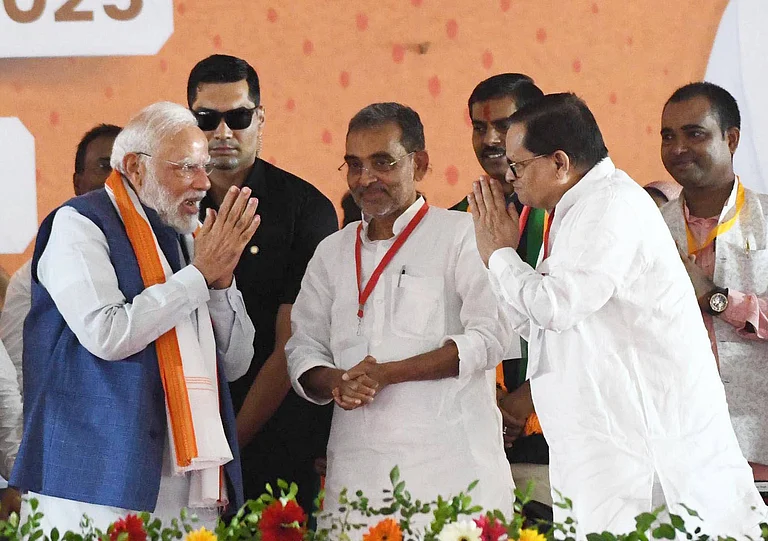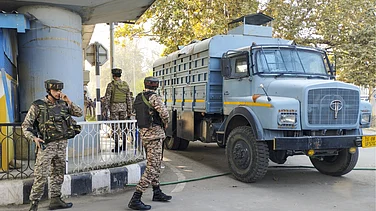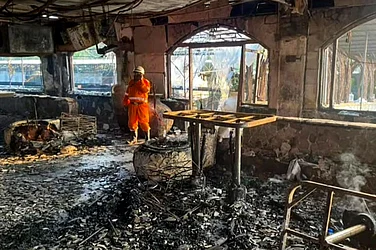As India gears up for the next Lok Sabha election, the ruling National Democratic Alliance (NDA) led by the BJP and the opposition Indian National Developmental Inclusive Alliance (INDIA) bloc are scrambling to bolster their positions. However, the path ahead is rife with challenges for the two rival formations.
The NDA retains the upper hand courtesy of Prime Minister Narendra Modi's enduring popularity and the BJP's unmatched election machinery. A resurgent NDA in recent state polls has also bolstered the opposition.
The BJP is falling back on a grand portrayal of Rural and Urban Development. Contentious issues like the uniform civil code and BJP’s Scheme for Vanvasis have returned to the party's agenda ahead of general elections. The Prime Minister addressing the National Convention of BJP on February 18 said, “BJP is the only party, and NDA is the only alliance that aspires to make India develop by 2047.”
Referring to the upcoming elections, he further said “The country has to take a giant leap toward Viksit Bharat in the next five years asserting that BJP's return to power is the first condition for achieving all goals.”
In the convention, a resolution with the title ‘BJP - Desh Ki Asha, Vipaksh Ki Hatasha’ said, the Opposition I.N.D.I. Alliance is getting broken day by day due to their infighting and directionless leadership.
Indian and the Coalition Politics
India's parliamentary democracy has long set an example for the developing world since its independence in 1947. However, behind the elections and transitions of power lies a fragmented political landscape that makes stable governance difficult; how the dominance of the Indian National Congress in the first three decades after independence which led to an era of coalitions at the Centre, was also marked by chronic political volatility.
Belying hopes that coalitions would lead to greater consensus in policymaking, the era has instead witnessed short-lived governments constantly at the mercy of their smaller allies.
Before the 6th General Elections of 1997, the Janata Party was formed under the leadership of Jaiprakash Narayan (JP). Janata Party was a grand political machinery of anti-congress leaders from Left - Right and Centre of the Political Spectrum. The Janta Party won the 1977 elections with 295 seats and 41 per cent of the total vote share. Morarji Desai under the guidance of JP, became the first sans congress prime minister. Chaudhary Charan Singh, another leader who left the congress to join Janata Party became the Deputy Prime Minister.
Just after two years, Chaudhary with his allies left the Janata Party to form another party called the Janata Party (Secular). The Morarji Desai Government fell down, and Singh became the new Prime Minister with the support of Indira Gandhi. Just after 23 days, Indira withdrew her support from the government and Singh remained the Prime Minister for the next 147 days until the General Elections of 1980.
Since 1977, when single-party majorities became a thing of the past, India has had six former Prime Ministers whose governments did not last a full term. Desai’s government fell in just two and half years, Charan Singh’s government fell within 23 days.
Three governments fell in just two years between 1996-98, two fell between 1998-1999, and another two governed for less than a year each in 1990 and 1998. Except for the full terms of Prime Ministers Vajpayee (1999-2004), Manmohan Singh (2004-14) and Narendra Modi since 2014, political volatility had become the norm.
The inherent fragility of Indian coalitions is down to incongruous alliances between parties with clashing ideologies, competing local interests, and oversized egos unsuited to power-sharing. With no single party even close to reaching the 272 seats required for a majority in India's massive 543-seat Lok Sabha, such fundamental clashes of political vision have to be papered over in the service of forming government. Minority and regional parties often punch above their weight, holding governments to ransom with threats of withdrawing support over relatively minor issues.
Congress vs BJP in Leading a Coalition
When it comes to helming coalition governments, both the BJP and the Congress have a tumultuous record providing stable governance despite unwieldy alliances. The core Hindutva ideology, centralized leadership of strong Prime Ministerial figures like Vajpayee and Modi and well-oiled party machinery have somehow allowed the BJP to retain control over ideological direction while regional satraps are given free rein in their states.
In contrast, the Congress' strong policy making during United Progressive Alliance (UPA)’s first term made it popular among the masses. But conflicting secular and socialist ideologies amongst allies also hamper Congress coalitions from reaching consensus on policies, leading to instability.
While BJP chief ministers like Shivraj Chouhan have served over a decade without major controversy, Congress alliances have seen chaos over leadership changes and defections in Karnataka, Madhya Pradesh, and other states. Coalitions like the UPA in the past have thus been sitting ducks for allies like Mamata Banerjee and Mayawati to paralyse governance over minor issues.
Similarly, the Congress-led INDIA Bloc is still facing challenges while Bihar CM Nitish Kumar and RLD Supremo Jayant Chaudhary left their hands to join the BJP-led NDA front.
When BJP Government Fell in 13 Days
The BJP came to power as the largest party in the general elections of 1996, but fell short of a majority. It formed a government on May 16th with the external support of regional parties like the AIADMK and the Telugu Desam Party. However, the Congress party, which was the main opposition, brought a no-confidence motion against the government on its very first day in parliament over the BJP's stand on contentious issues like the Babri Masjid demolition.
During the debate and vote on the motion, the BJP's allies abandoned their support seeing the numbers stacked against the government. The final vote result was 251 voting in favor of the motion and 264 against, leading to calls for Vajpayee's resignation.
When Congress Faced Trust Vote in the Parliament
Facing a trust vote in parliament over the controversial India-US civil nuclear deal, the Congress-led UPA government secured a wafer-thin victory in July 2008. With the Left parties withdrawing support over the deal and the BJP also voting against it despite backing Indo-US ties, the government relied on the Samajwadi Party's support to scrape through.
Ahead of the trust vote, SP chief Mulayam Singh Yadav claimed former President APJ Abdul Kalam had endorsed the nuclear deal as beneficial for India. This allowed the SP to back the government while claiming high moral ground.
The tense two-day debate was hailed as one of parliament's finest, but polarisation was complete. Expelled CPM leader Somnath Chatterjee defied his party to remain Speaker and facilitate the vote. The UPA victory opened the gates for India to engage in nuclear trade after decades of isolation. However, it came at the cost of sacrificing a stable government dependent on Left support.
The trust vote marked the beginning of the crisis of credibility that would ultimately bring the UPA down. But in 2008, amidst the storm it unleashed, the landmark deal held promise as India's gateway to the global high table.
Coalition governments and Political Volatility
The costs of such political volatility are significant. Coalition governments struggle to find consensus across allied parties to initiate major economic reforms or big infrastructure projects that may require short-term pain but promise long-term gain. Economic growth and governance inevitably become casualties.
India's era of coalition politics has made government formation complex but governance even more so. As different regional parties with divergent agendas make compromises to grab power, a unique set of challenges undermines their ability to deliver effective administration.
While the Nation’s regional diversity undoubtedly needs coalition representation but seeing at the history of coalition politics in India, political analysts argue governments have become weak by allies pulling in different directions.



























